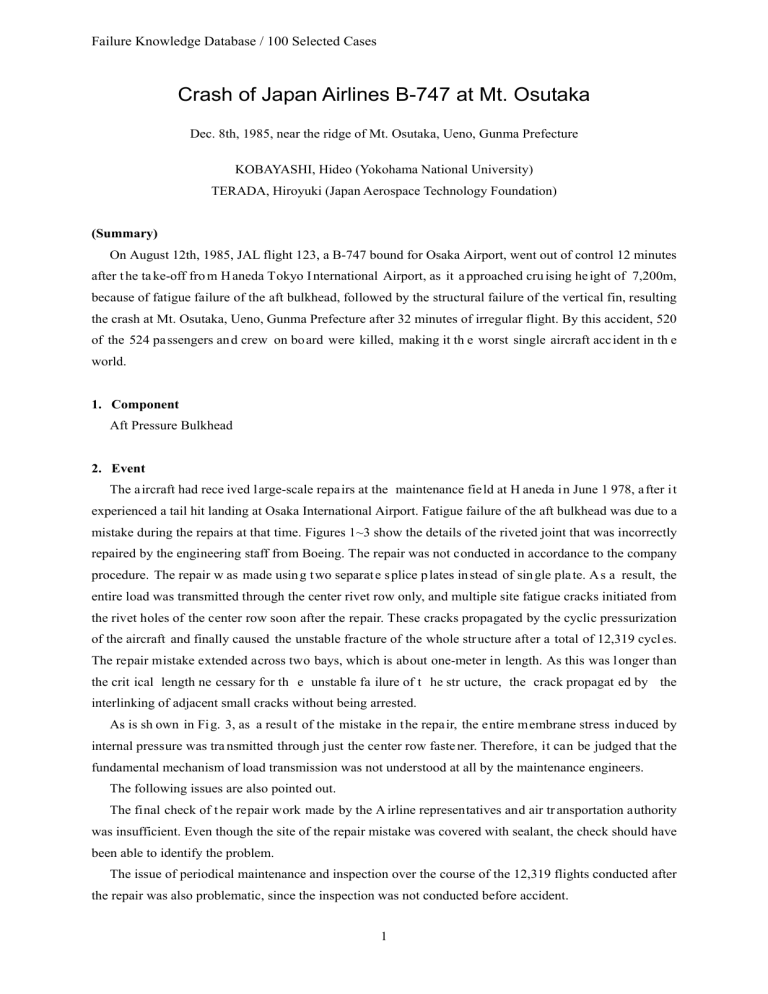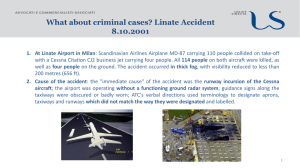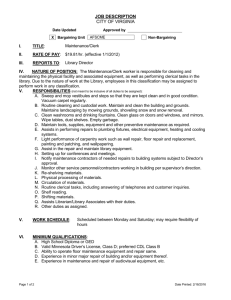Crash of Japan Airlines B

Failure Knowledge Database / 100 Selected Cases
Crash of Japan Airlines B-747 at Mt. Osutaka
Dec. 8th, 1985, near the ridge of Mt. Osutaka, Ueno, Gunma Prefecture
KOBAYASHI, Hideo (Yokohama National University)
TERADA, Hiroyuki (Japan Aerospace Technology Foundation)
(Summary)
On August 12th, 1985, JAL flight 123, a B-747 bound for Osaka Airport, went out of control 12 minutes after the take-off fro m Haneda Tokyo International Airport, as it approached cruising height of 7,200m, because of fatigue failure of the aft bulkhead, followed by the structural failure of the vertical fin, resulting the crash at Mt. Osutaka, Ueno, Gunma Prefecture after 32 minutes of irregular flight. By this accident, 520 of the 524 passengers and crew on board were killed, making it th e worst single aircraft accident in th e world.
1.
Component
Aft Pressure Bulkhead
2.
Event
The aircraft had rece ived large-scale repairs at the maintenance field at H aneda in June 1 978, after it experienced a tail hit landing at Osaka International Airport. Fatigue failure of the aft bulkhead was due to a mistake during the repairs at that time. Figures 1~3 show the details of the riveted joint that was incorrectly repaired by the engineering staff from Boeing. The repair was not conducted in accordance to the company procedure. The repair w as made using two separate splice plates instead of single plate. As a result, the entire load was transmitted through the center rivet row only, and multiple site fatigue cracks initiated from the rivet holes of the center row soon after the repair. These cracks propagated by the cyclic pressurization of the aircraft and finally caused the unstable fracture of the whole structure after a total of 12,319 cycles.
The repair mistake extended across two bays, which is about one-meter in length. As this was longer than the crit ical length ne cessary for th e unstable fa ilure of t he str ucture, the crack propagat ed by the interlinking of adjacent small cracks without being arrested.
As is sh own in Fig. 3, as a result of the mistake in the repair, the entire membrane stress induced by internal pressure was tra nsmitted through just the center row faste ner. Therefore, it can be judged that the fundamental mechanism of load transmission was not understood at all by the maintenance engineers.
The following issues are also pointed out.
The final check of t he repair work made by the A irline representatives and air transportation authority was insufficient. Even though the site of the repair mistake was covered with sealant, the check should have been able to identify the problem.
The issue of periodical maintenance and inspection over the course of the 12,319 flights conducted after the repair was also problematic, since the inspection was not conducted before accident.
1
Failure Knowledge Database / 100 Selected Cases
3.
Course
Many structural parts of the vertical fin were retrieved from Suruga Bay, where the first decompression occurred. The most of t he wreckage was found at the site of crash. The wreckage of t he aft fuselage was reconstructed at the Chofu Airfield, and the initial investigation focused mainly on the cause of the fracture of the aft pressure bulkhead.
4.
Cause
The direct c ause of th e a ccident w as t he fati gue fai lure of t he aft bulkhead as s hown in Fig. 1. T he central hydra ulic c ontrolling system and APU loc ated at t he ba ck of b ulkhead a s w ell as the box-beam structure of the vertical fin were blown off by the large mass of air moving a hypersonic velocity that was induced by this breakage.
As a result of the total loss of hy draulic pressure, the aircraft went out of control and fi nally crashed near the ridge of Mt. Osutaka, although it was able to stay in the air for 32 minutes and avoid an immediate mid-air explosion.
5.
Immediate Action
Among other investigations, the aft pressure bulkhead where the large-scale repairs had been conducted after the tail hit a ccident a t Osaka air port seven years ago were cl osely examined. Deta iled fract graphy observations of the fracture surface of the fastener joint were made.
6.
Countermeasure
Even though the main cause of the ac cident was the mistake during the repair of the pressure bulkhead conducted seven years befo re the accident, the direct cause that led the aircraft losing control was the loss of the hydraulic control unit and the vertical fin. The Aircraft Accident Investigation Commission advised the manufacturer and opera tor to re inforce the torsi on bo x structure by inst alling a plat e t o prevent t he high-speed airflow fro m ent ering t he box beam in t he event th at the pressure bu lkhead do es burst. The advice was put into practice.
7.
Knowledge
(1) Inspections conducted at appropriate intervals are indispensable, especially after a large-scale repair or design c hange has been c arried out in order t o e nsure tha t t he d esigner's intent ion is c ompletely satisfied.
(2) Fundamental training and education in areas such as the mechanics of materials should be provided in detail even for the engineers at the site.
(3) The people who are responsible for signing the document of approval of repairs should check the site carefully to assure that those repairs were conducted as desired.
8.
Background
The system for ensuring the structur al integrity after a l arge-scale repair was inadequate. At JAL, th e
2
Failure Knowledge Database / 100 Selected Cases
concept of m aking freq uent i nspections that is esse ntial for e nsuring th e integrity of th e s tructures, especially when a large-scale repair was conducted as the present case, did not exist.
9.
Sequel
The fast and unstable fracture of the pressure bulkhead of the jumbo jet aircraft was the result of t he propagation and linking up of multiple site cracks that emanated from the riv et holes. Figure 6 s hows the behaviors of t hese cracks at the location L18 of the fas tener joint. Because of the mistake in the repair of the b ulkhead, t he lo ad was tra nsmitted t hrough t he ce nter row fas tener only. Because t he stress be came highly concentrated there, multiple-site cracks started from many of th e fastener holes, and those cracks linked-up to became long enough after 12,300 pressurization cycles to cause the fracture. In fac t, it was reported that fatigue cracks were observed at more than 30 of the 50 fastener holes in the repaired area, and total length of the cracks was more than 270 mm. These damages led to the fatigue failure of the bulkhead in the last flight.
One reason why multiple-site cracks occurred is that the old rivet holes were used again at the repair without resizing the holes. The JAL accident showed the potential danger of multiple-site cracks.
Three years later, on April 4th, 1988, another accident caused by multi-site damage occurred in Hawaii.
This time a la rge part of the fuselage structure of a B-737 operated by Aloha Airlines was blown off while cru ising. These two accident c ases that we re ca used by m ultiple-site d amage (M SD) a nd multiple-element damage (MED) showed that the damage tolerant design concept based on the behavior of a single crack is insufficient for such cases.
Since the accident of Comet-I, disasters caused by fatigue failure was repeated after 31 years. The cause of the Comet accident was a design problem that was common to the entire fleet, while in the case of the
JAL accident the problem was in the repair and therefore was an individual matter. By tracing the history of fatigue related accidents, one can suggest the direction of future research on this subject.
10.
On the Side
In 1989, a similar accident occurred in the USA. A DC-10 operated by United Airlines lost control when the entire hydraulic system was totally damaged because of th e failure of th e compressor fan d isk of t he first stage in the second engine located at the empennage. However, in contrast to the JAL case where the cockpit crew did not recognize the severity of the situation and insisted on returning to the original airport, the crew of DC-10 correc tly un derstood th at t he e ngine co ntrolling t he hy draulic un it w as fractured .
Therefore they tried to land at the nearest airstrip as s oon as possible. Although they were forced to m ake crash landing an d a fire broke o ut s oon after the t ouch down, m ore th an 6 0% of th e people on- board survived.
If the pilot is able to correctly assess what is occurring on the aircraft and operate according to t hat assessment, the worst results can always be avoided. In the case of the JAL accident, the pilot thought that he c ould ret urn safely bec ause h e t hought t hat only t he rear car go door (R 5 D oor) w as fractured, even though t here had been t ime to understand t he fa cts of the s ituation correc tly w ith the s upport of o ther aircraft, as the aircraft was able to stay in the air for 32 minutes.
3
Failure Knowledge Database / 100 Selected Cases
11.
Social Impact
As the accident involved a Jumbo Jet that is used all over the world, much concern was raised just after the tragedy as to whether or not the accident cause was common to the fleet.
The accident was long talked about as a tragedy, because so many people were killed. JAL, the biggest airline in Japan, lost much of its cred ibility, and it took long time to regain consumer trust in the company and restore the number of air travelers in Japan.
12.
Information Source
(1) Aircraft Accident In vestigation R eport 62-2 (1 987), Aircraft A ccident Inv estigation C ommission,
Ministry of Transportation of Japan.
(2) H. Kobayashi, Safety Engineering, 26-338 (1987).
13.
Primary Scenario
01. Ignorance
02. Insufficient Knowledge
03. Lack of Learning
04. Carelessness
05. Insufficient Precaution
06. Carelessness of Worker
07. Misjudgment
08. Misperception
0 9. Misapprehension/Misread
10. Ignorance of Procedure
11. Insufficient Communication
12. Lack of Confirmation
13. Usage
14. Maintenance/Repair
15. Change of Components
16. Pressure Bulkhead
17. Usage
18. Maintenance/Repair
19. Poor Inspection
20. Failure
21. Fracture/Damage
22. Fatigue
23. Unstable Fracture of Bulkhead
24. Failure
25. Fracture/Damage
4
Failure Knowledge Database / 100 Selected Cases
26. Fracture of Vertical Fin
27. Non-Regular Action
28. Emergency Action
29. Stricture of Judgment
30. Malfunction
31. Poor Hardware
32. Malfunction of Control System
33. Failure
34. Large-Scale Damage
35. Crashes
36. Damage to Society
37. Change in Perception
38. Distrust to Enterprise and Authority
39. Decrease in Customers
5
Failure Knowledge Database / 100 Selected Cases
Torsion strength of box beam become zero as all panels fastened by single row river were torn-off by hyper airflow
Vertical fin
② ③
Hypersonic airflow
Hydraulic pipe
①
Rudder
Sequence of fracture
①→②→③
②
①
Central hydraulic unit
R5 door
Aft Pressure Bulkhead
Fig. 1 Structure near the Empennage.
Auxiliary Power unit
6
Failure Knowledge Database / 100 Selected Cases
Pressure Bulkhead Mis-repair False Inspection Malfunction Fatigue Failure Structural Failur Induced Results
Yes
Inspection/Repair
Yes
Yes
No
No
Yes
No
Yes
No
Loss of Control
Forced Landing
Periodical Maintenance
Re-repair
No
Integrity
Fig. 2 Event Tree Analysis of JAL Accident Caused by Miss-repair of AFT Pressure.
7
Failure Knowledge Database / 100 Selected Cases
Pressure Bulkhead Burst
Aircraft Response
Irregular
Aircraft Response
Normal
Periodical Inspection
Yes
Periodical Inspection
No
Periodical Inspection
Error Inspection
Transfer
Transfer Inspection
Error
Transfer Inspection
Correct
Transfer Inspection
Not inspected
Miss-Repair False Design Repair Other
Other
Bottom Hit Landing
Fig. 3 Fault Tree Analysis of JAL Accident Caused by Miss-repair of Aft Pressure.
8
Failure Knowledge Database / 100 Selected Cases
Stiffener
L14
L12
Web
L16
Upper
Bay1
Bay2
Bay3
Bay4
L18
Double row fastener Single row fastener Double row fastener
Bay5
L22
Collector Ring
Web
Part of aft pressure bulkhead seen from Tail side
Upper bulkhead
Force Flow
Splice plate
L18 Stiffener
Force Flow
Sealant
Sealant
Rivet
Miss-repaired
Hatched part should be single plate
Fracture site
Force concentrated at this row
Splice plate
Lower Bulkhead
(cabin side) (outside)
Directed Repair
Actual Repair
Fig. 4 The Aspect of Aft Bulkhead Repair.
9



